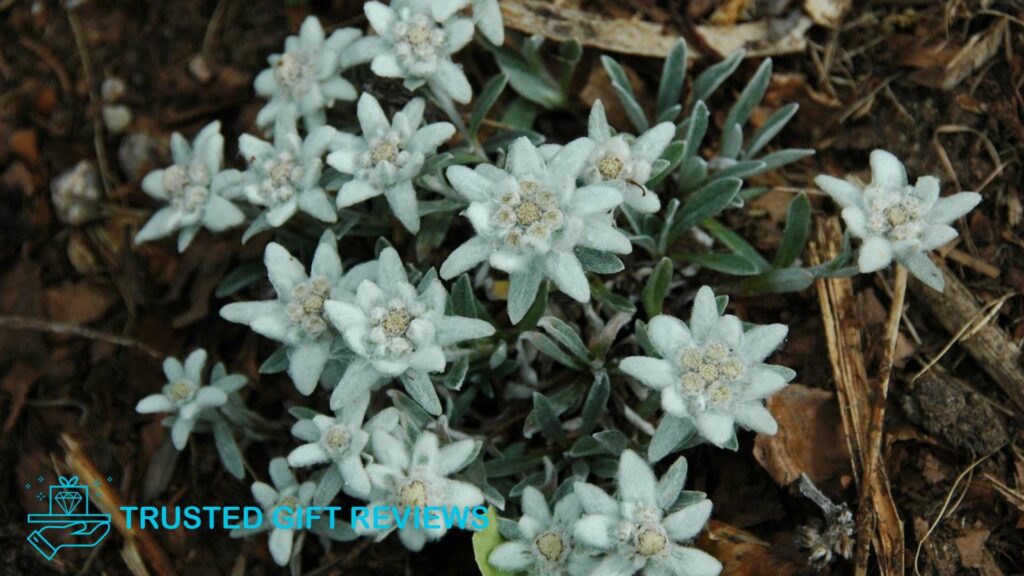There are rare beauties hiding in the mountains of the Alps called edelweiss. They’re like little treasures that act as a reward after going through the tough terrain of the range.
However, these tough little flowers are more than just pretty blooms. They also stand for resilience.
In this article, we’ll take a closer look at the edelweiss flower and how you can use them as gifts. We’ll explore their meanings, their significance to the people who live near them, and their uses in both medicine and gardening.
How did the edelweiss flower get its name?


The name edelweiss comes from two German terms, “edel” and “weiß.”
“Edel” is the German term for noble, which reflects the common perception of the edelweiss flower as a special and valuable plant. “Weiß,” on the other hand, means white, referring to the color of the flowers.
The name edelweiss essentially means “noble white.” German botanists were the first to use the name when referring to the flower.
How did the edelweiss flower get the name Leontopodium nivale?


The name Leontopodium is a combination of the Greek words “leon” meaning lion and “podion” meaning paw. These describe the wooly bracts of the plant that look similar to a lion’s paw.
The word nivale, on the other hand, is a Latin word that means snowy or white.
What other names does the edelweiss flower have?


The name edelweiss is recognized globally as the common name for the plant, but certain regions call the plant other names.
For Romanians, the edelweiss flower is more commonly known as floare de colt, which translates to cliffhanger flower.
The French and Italians living in the Alps also have different names for the flower. The Italians refer to it as stella Alpina, while the French call it étoile des Alpes, both meaning “star of the Alps.”
What is the botanical origin of the edelweiss flower?


The edelweiss flower is a small, white, star-shaped plant that belongs to the Leontopodium genus of the Asteraceae family. It’s native to Mongolia, Tibet, and the Himalayas.
However, they’re now mostly seen in high mountain regions in Europe, particularly in Alpine countries like Switzerland, Slovenia, Austria, France, and more.
These flowers can also be grown in your backyard if you provide them with the necessary care and growing conditions. Here are some frequently asked questions about growing edelweiss flowers at home:
Where do edelweiss flowers grow?
Edelweiss flowers primarily thrive in European regions with high altitudes, such as the Alps, the Pyrenees, and the Carpathians.
Some gardeners, though, have started planting these flowers in their homes because of their beauty. It’s also their way to help conserve these flowers and prevent their extinction.
Do edelweiss flowers require maintenance?
Edelweiss flowers are relatively low maintenance. Thriving in challenging high-altitude environments, these flowers can survive without fertilizers and adapt well to diverse growing conditions.
Moreover, they are not susceptible to pests and diseases, which makes taking care of them easier.
Do edelweiss flowers need shade or sun?
Edelweiss flowers thrive in full sun. Since they grow in high altitude, they’re exposed to intense sunlight, and it’s best to mimic this when growing them in your garden.
Provide the flowers with at least 6 hours of direct sunlight every day for best results.
When do edelweiss flowers bloom?
Typically, edelweiss blooms from late spring to early fall. However, those growing in extremely high altitudes may bloom in early summer.
The altitude plays a huge role in determining the blooming time of these plants. Plants tend to bloom much later at higher elevations, where snow and cold temperatures persist longer.
What kind of soil do edelweiss flowers prefer?
Edelweiss thrive in soils that are similar to their natural alpine habitat. This means the soil has to be well-draining, rocky, with a neutral pH of 6.5 to 7.5, and with a bit of lime.
If you’re making your own mix, add pebbles, lime, stand, and peat moss to the soil mix to make it more appropriate for edelweiss flowers.
When is the best time to plant edelweiss flowers?
The ideal time to plant edelweiss is when the frost subsides and the soil starts to warm up. This is usually around early to mid-spring, depending on where you live.
This timing ensures the plant can establish roots and grow before the soil temperature rises to levels that may hinder its growth.
What do edelweiss flowers mean?


Edelweiss flowers are generally used to symbolize devotion, dedication, true love, innocence, purity, elegance, nobility, and perfection. Some regions may also have different meanings for the flower, like patriotism and defiance in Austria.
What do the colors of edelweiss flowers mean?


Unlike other plants and flowers that come in a wide variety of colors, edelweiss flowers can only be found in white color.
Edelweiss’ white color generally represents innocence, beauty, and the rugged, pristine landscapes of alpine regions. It also serves as a symbol of resilience due to the flower’s ability to maintain its white beauty despite harsh climates.
The white color of the flower is also symbolic of the purity of one’s true love.
What did the edelweiss symbolize in various historical periods?


What are the cultural associations of the edelweiss flower?


What are the uses of the edelweiss flower?


The edelweiss flower can be used for various purposes, including gifting, gardening, and skincare. Its medicinal benefits were widely recognized in the past, and its ornamental value makes it a great gift and addition to any garden.
How can edelweiss flowers be used in medicine?


Edelweiss flowers can be used to make poultices or ointments that can heal wounds, irritated skin, infections, and more. They have anti-inflammatory effects that help soothe irritated skin.
The edelweiss flower is also featured in some sunscreens and anti-aging creams because of its ability to shield skin from harmful UV radiation. Some moisturizers also have edelweiss extract because of the flower’s anti-inflammatory properties.
However, it’s important to note that the use of edelweiss in modern medicine is limited, and there are not a lot of studies about it. Ask for a professional’s opinion before using the flower to treat any disease you may have.
How can edelweiss flowers be used in gardening?


Edelweiss flowers can be planted in both garden beds and pots to add a captivating charm to your garden. These uncommon flowers are typically found in mountainous regions, so having them in your garden can make it more special.
Edelweiss is especially suitable for rock gardens because it prefers well-draining soil. Planting it among rocks, gravel, or small stones will help recreate its natural mountain environment.
Additionally, these flowers have a low-growth habit, making them a perfect companion for taller plants. They’re also not vulnerable to pests and other plant diseases, so they won’t harm your other plants.
If you’re considering planting edelweiss in your garden, ensure the soil mix has good aeration and drainage. It’s also best to use rocky or sandy soils to mimic the plant’s natural alpine habitat.
How can edelweiss flowers be used in events?


Incorporate edelweiss flowers in bouquets, centerpieces, and corsages. They are the perfect wedding flowers for anyone.
The flower can symbolize the couple’s true love and dedication to withstand any adversity they may face during their marriage.
You can also prepare a basket or bouquet of edelweiss for your partner as a gift for your anniversary as a sign of your loyalty and devotion to them.




